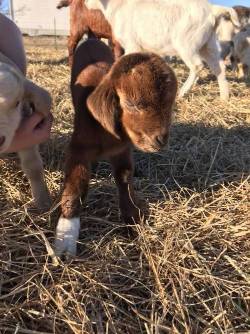Goat Production
Thinking about starting a goat operation? You’re in the right spot! This page is not a detailed management guide, but rather an overview of things for you to consider before taking the plunge and raising goats. To start at the very beginning, there are three basic types of goats: meat goats, dairy goats and fiber goats. Some producers focus on one type of goat, while others may include all three in their operation. Meat & Dairy Goats are the two types that are most popular in our area. Your interests, abilities and resources available should determine what type of operation you choose to build.
Breeds
Meat
Goats from all breeds can be slaughtered for their meat. However, there are a few breeds that are more specialized for meat production. The Boer goat breed is the most popular meat production breed. It was developed from the native goat population in South Africa, which the possible addition of European and Indian breeds. Boer goats were first imported in the United States in 1993, from New Zealand. Other goat breeds suited for meat production include: Spanish, Pygmy, Kiko and Myotonic(Fainting Goats).
Diary
The American Dairy Goat Association recognizes eight breeds of dairy goats. The breeds the ADGA recognizes for their high milk production are the Alpine, Lamancha, Nigerian Dwarf, Nubian, Oberhasli, Saanen, Sable and Toggenburg. Choosing which breed to raise should depend on both the amount of milk produced as well as the quality of milk produced. Higher fat & protein content indicates higher quality milk.
City of Lawrence:
Only small goats and sheep are permitted as Small Animal Agriculture. Breeds which would be considered small goats include Pygmy Goats, Nigerian Dwarf Goat, and Miniature Dairy Goats. Breeds which would be considered small sheep include Harlequin Sheep, North American Shetland Sheep, and Chevoit Sheep.Breeds are limited to those that do not exceed 24” at the withers.
Nutrition
Goats require the same basic groups of nutrients as other animals: water, protein, energy, minerals and vitamins. Animals of different breeds and ages require different amounts of nutrients. Goats are ruminants, meaning they have a multi-chambered stomach that enables them to digest forages much more readily. To maintain production and good health, goats should be fed a diet balanced for energy, protein, minerals, and vitamins.
Nutrient requirements are often expressed in pounds per day. Animals eating coarse, mature forages may not be able to consume enough to meet their needs, while those eating lush, immature forages may take in more nutrients than needed. Supplementing the diet with grain mixes to provide additional energy and protein when needed. Grain mixes may also contain supplemental minerals and vitamins.
Plenty of fresh, clean water is essential for goats. The most common watering methods are automatic bowls, galvanized or plastic tanks. During winter months, you can use a simple tank heater to keep the water from freezing.
Facilities
Fencing
Fencing is the most important aspect of goat facilities. Goats are natural climbers and are very curious. They will test their limits with fences and attempt to escape from confinement no matter how much space they are given. Fencing for goats should serve the dual purpose of keeping the goats in and keeping predators out.
Housing
Goats are very adaptive animals and don’t require extravagant housing. However, they do need protection from rain, wind and sun. In the summer, it’s important to provide shade and adequate fly control for goats. During fall, winter and spring months, goats require shelter from cold rain and snow.
City of Lawrence:
a. Goats and sheep shall be housed in a predator-resistant, covered structure with an open air enclosure.
b. The structure shall be located a minimum of 50 feet from any off-site dwelling.
c. The structure shall be located in the rear yard and a minimum of 15 feet from adjacent properties.
d. The structure shall provide a minimum of 10 square feet of living area per goat or sheep.
e. A fenced open air enclosure shall be provided which has a minimum area of 150 square feet per goat or sheep.
Reproduction
Reproduction is an extremely important part of a successful goat production operation. If your herd does not breed, your milk goats won’t produce milk and your meat goats won’t have offspring to sell. A doe reaches puberty at 7-10 months of age, depending on her breed and level of nutrition. Does should weigh at least 60% - 75& of her adults weight before they’re bred. Kids are born about 150 days after breeding. Before you turn a buck in with your herd, you should have a veterinarian check the animal for overall health and perform a breeding soundness exam.
Links
American Boer Goat Association
American Dairy Goat Association
NAHMS Goat Studies and Fact Sheets

